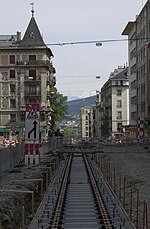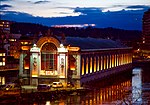Institut et Musée Voltaire
Biographical museums in SwitzerlandHistoric house museums in SwitzerlandLiterary museums in SwitzerlandMuseums in GenevaVoltaire

The Institut et Musée Voltaire is a museum in Geneva dedicated to the life and works of Voltaire. The museum is housed in Les Délices, which was Voltaire's home from 1755 until 1760. The property was bought by the city of Geneva in 1929, and the museum opened in 1952, founded by Theodore Besterman.It contains about 25,000 volumes on Voltaire and the 18th century as well as a collection of paintings and prints from the period, many depicting Voltaire, his relatives and acquaintances.
Excerpt from the Wikipedia article Institut et Musée Voltaire (License: CC BY-SA 3.0, Authors, Images).Institut et Musée Voltaire
Rue des Délices, Geneva Saint-Jean et Charmilles
Geographical coordinates (GPS) Address Website External links Nearby Places Show on map
Geographical coordinates (GPS)
| Latitude | Longitude |
|---|---|
| N 46.2076 ° | E 6.1335 ° |
Address
Musée Voltaire
Rue des Délices 25
8973 Geneva, Saint-Jean et Charmilles
Geneva, Switzerland
Open on Google Maps







